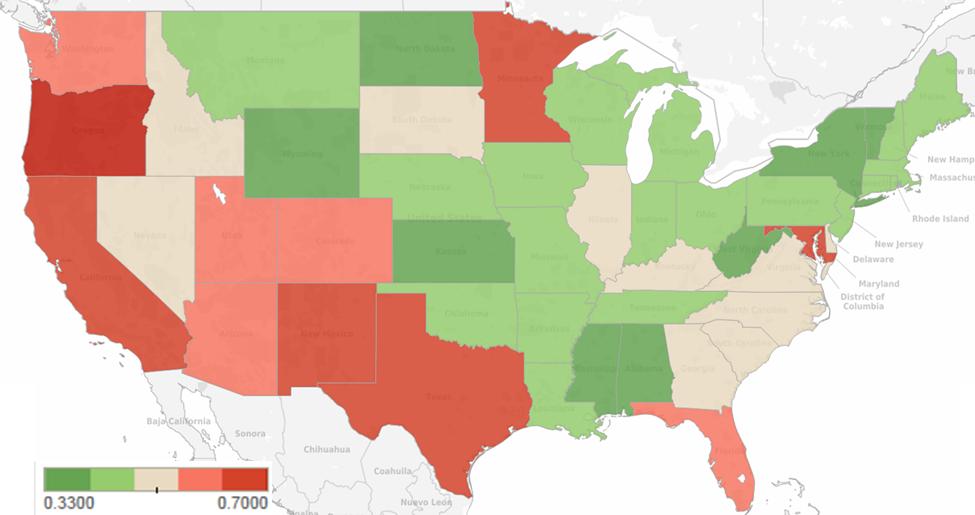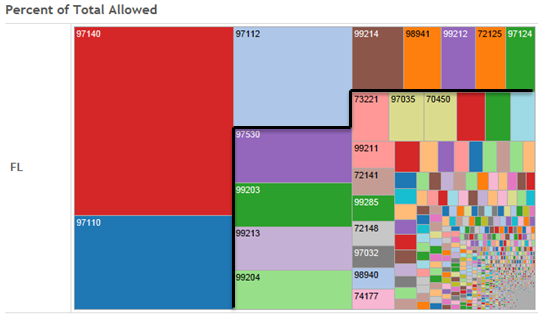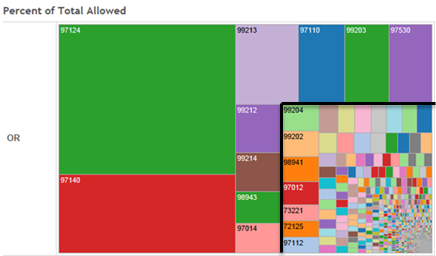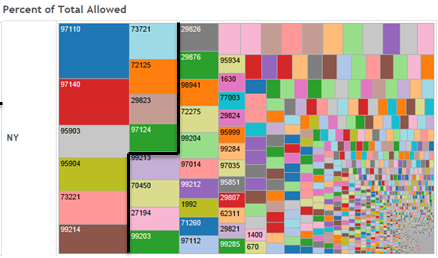Investigation into the top 10 procedure codes, based on total allowed amount, experienced by the auto casualty insurance marketplace provides valuable insight for claims organizations, investigators and legislators. With thousands of possible medical services available to medical providers, the injury types seen in motor vehicle accident claims lend themselves to a select number of treatments. On a national level the top 10 professional service procedure codes billed in 2014 accounted for 48 percent of the total allowance for professional medical services with the range by state of jurisdiction starting at 33 percent for New York and ending at 69 percent for Oregon.
Top 10 ICD-10 Codes in the U.S.
- 72141 Magnetic resonance (e.g., proton) imaging, spinal canal and contents, cervical; without contrast material.
- 72148 Magnetic resonance (e.g., proton) imaging, spinal canal and contents, lumbar; without contrast material.
- 97012 Application of a modality to 1 or more areas; traction, mechanical.
- 97014 Application of a modality to 1 or more areas; electrical stimulation (unattended).
- 97110 Therapeutic procedure, 1 or more areas, each 15 minutes; therapeutic exercises to develop strength and endurance, range of motion and flexibility.
- 97124 Therapeutic procedure, 1 or more areas, each 15 minutes; massage, including effleurage, petrissage and/or tapotement (stroking, compression, percussion).
- 97140 Manual therapy techniques (e.g., mobilization/ manipulation, manual lymphatic drainage, manual traction), 1 or more regions, each 15 minutes.
- 98940 Chiropractic manipulative treatment (CMT); spinal, 1-2 regions.
- 98941 Chiropractic manipulative treatment (CMT); spinal, 3-4 regions.
- 99284 Emergency department visit for the evaluation and management of a patient, which requires these 3 key components: a detailed history, a detailed examination and medical decision making of moderate complexity.
By limiting investigation to the top 10 procedure codes the user is not overwhelmed by a vast dataset with many false positive findings that delay appropriate conclusions; rather they are left with a clear picture of the medical community’s treatments of choice and how these services are driving results in a particular state of jurisdiction. Simply mapping this high level snapshot of what the top 10 procedure codes represented of total allowed for the state of jurisdiction starts to paint a picture where patterns may drive organizational alignment and on time training.
 In addition to the great variability in cost associated with the top 10 procedure codes state to state, there is also great variability in procedure code mix. Occasionally, variability in procedure code mix is the result of the rules that govern the medical fee schedule for the state while in other instances it is the result of a combination of the medical community’s standard of care and billing practices. It would be important for a claim organization looking to effectively manage claim outcomes, by ensuring accurate claim settlement, to fully understand the ten procedure codes making up the majority of their claim costs. By understanding the makeup of a state’s 10 most costly procedure codes, a claim organization can better train their claim handlers and investigators and proactively modify claim handling procedures as trends change or emerge.
In addition to the great variability in cost associated with the top 10 procedure codes state to state, there is also great variability in procedure code mix. Occasionally, variability in procedure code mix is the result of the rules that govern the medical fee schedule for the state while in other instances it is the result of a combination of the medical community’s standard of care and billing practices. It would be important for a claim organization looking to effectively manage claim outcomes, by ensuring accurate claim settlement, to fully understand the ten procedure codes making up the majority of their claim costs. By understanding the makeup of a state’s 10 most costly procedure codes, a claim organization can better train their claim handlers and investigators and proactively modify claim handling procedures as trends change or emerge.
Through the use of a heat mapping tool you quickly see the variability between states of jurisdiction. Understanding that nearly 70 percent of all professional medical services in Oregon are due to ten procedures while in New York the top 10 procedure codes only represent 33 percent of total allowed affords a claim organization the opportunity to make decisions from a position of strength. If a claim organization was looking to consolidate claims or introduce an expedited claim handling process they might want the less experienced claim handlers assigned to Oregon claims or pilot their new claim process on Oregon claims since the majority of claim cost is associated with ten procedure codes.
However, “fully assimilating the knowledge that each state of jurisdiction has its own procedure code fingerprint will allow a claim organization to move from a general claim handling process to a state specific claim handing process that improves the efficiency and effectiveness of the entire organization while looking to answer the underlying question, why are similar injuries treated so differently in each state?” states Michele Iacobacci, vice president, Information Management & Support for Mitchel International.
Examination of the Oregon and New York heat maps for all procedure codes encountered in 2014 highlights the great diversity of medical service experienced in New York claims. It also reveals that the top 10 procedure codes fall into two larger categories of medical service; physical medicine and evaluation and management. Evaluation and management services have specific criteria established by the American Medical Association’s Current Procedural Terminology (CPT) reference that a provider’s medical documentation must meet or exceed in order to support the level of service. While understanding medical documentation requirements is essential for all claim handlers it is particularly important for Oregon claim handlers, as evaluation and management services account for a larger percent of total claim payments than in other states.
The second category, physical medicine services, also have documentation requirements established by the CPT reference manual (i.e., one or more areas; each 15 minutes) but additional resources would be required to create training material that addresses the medical necessity and appropriateness of treatment. However, even with the need to incorporate the additional resources that address the medical necessity of physical medicine services it would still be less labor intensive and more easily assimilated by inexperienced claim handlers than the New York training with its diverse group of procedures. While Oregon’s top 10 procedure codes could be placed in two major categories, New York’s top 10 procedure codes can be placed in five categories: physical medicine, evaluation and management, nerve testing, radiology services and surgical procedures. Identifying all of the necessary references that describe medical necessity and appropriate utilization of these five categories of medical service would be cumbersome and once identified not easily incorporated into a new hire training material. While reference materials generally do a great job of explaining the medical necessity and use of specific procedure codes, treatment is both an art and science making assimilation of the material quite challenging.
Another advantage that claim organizations will have with a thorough understanding of the top 10 procedure codes involves out of state claims or those claims that move back and forth between states of jurisdiction. How does the procedure code fingerprint come to play when snowbirds travel between two states as the seasons change? Examination of the top 10 procedure codes fingerprint for Florida reveals many similarities to Oregon that end with its top 10 procedure codes easily placed into the two large categories of physical medicine and evaluation and management. If a claim were to originate in Florida and the claimant subsequently moved to New York where nerve testing dominates the medical landscape, as depicted by the fingerprint, would the claim handler be equipped with the knowledge and experience to ensure the claim is handled appropriately? If the claim handler worked in an organization that embraced the knowledge of the top 10 procedure code fingerprint, the claim handler could confidently manage the claim recognizing that they may encounter medical services not common to Florida claims. Simply having the knowledge that unfamiliar services may be encountered with a claim that originated in another state mitigates the possibility of delayed claim handling and improves customer satisfaction and claim outcome.
 Considering the use of data analytics as part of a big data initiative can be overwhelming to some. Carving up all of the medical service data encountered by the auto casualty insurance market into manageable pieces can make the process less stressful and more productive. Simply looking at ten medical procedure codes and understanding their state specific impact and emerging trends will make any claim organization more efficient while ensuring their claim resolution is accurate. This knowledge can take a claim organization from one with general handling procedure to one that embraced state specific claim handling procedures.
Considering the use of data analytics as part of a big data initiative can be overwhelming to some. Carving up all of the medical service data encountered by the auto casualty insurance market into manageable pieces can make the process less stressful and more productive. Simply looking at ten medical procedure codes and understanding their state specific impact and emerging trends will make any claim organization more efficient while ensuring their claim resolution is accurate. This knowledge can take a claim organization from one with general handling procedure to one that embraced state specific claim handling procedures.
By Edward Olsen, DC, CPCU, senior business process consultant, Mitchell International
Was this article valuable?
Here are more articles you may enjoy.



 Baltic Sea Countries to Check Insurance on Tankers Moving Russian Oil
Baltic Sea Countries to Check Insurance on Tankers Moving Russian Oil  Nearly 1,000 Feared Dead After Cyclone Hits France’s Mayotte
Nearly 1,000 Feared Dead After Cyclone Hits France’s Mayotte  CVS Accused of Illegal Opioid Dispensing in Whistleblower Suit
CVS Accused of Illegal Opioid Dispensing in Whistleblower Suit  Cargo Theft Surges as Holiday Season Approaches, Verisk Says
Cargo Theft Surges as Holiday Season Approaches, Verisk Says 